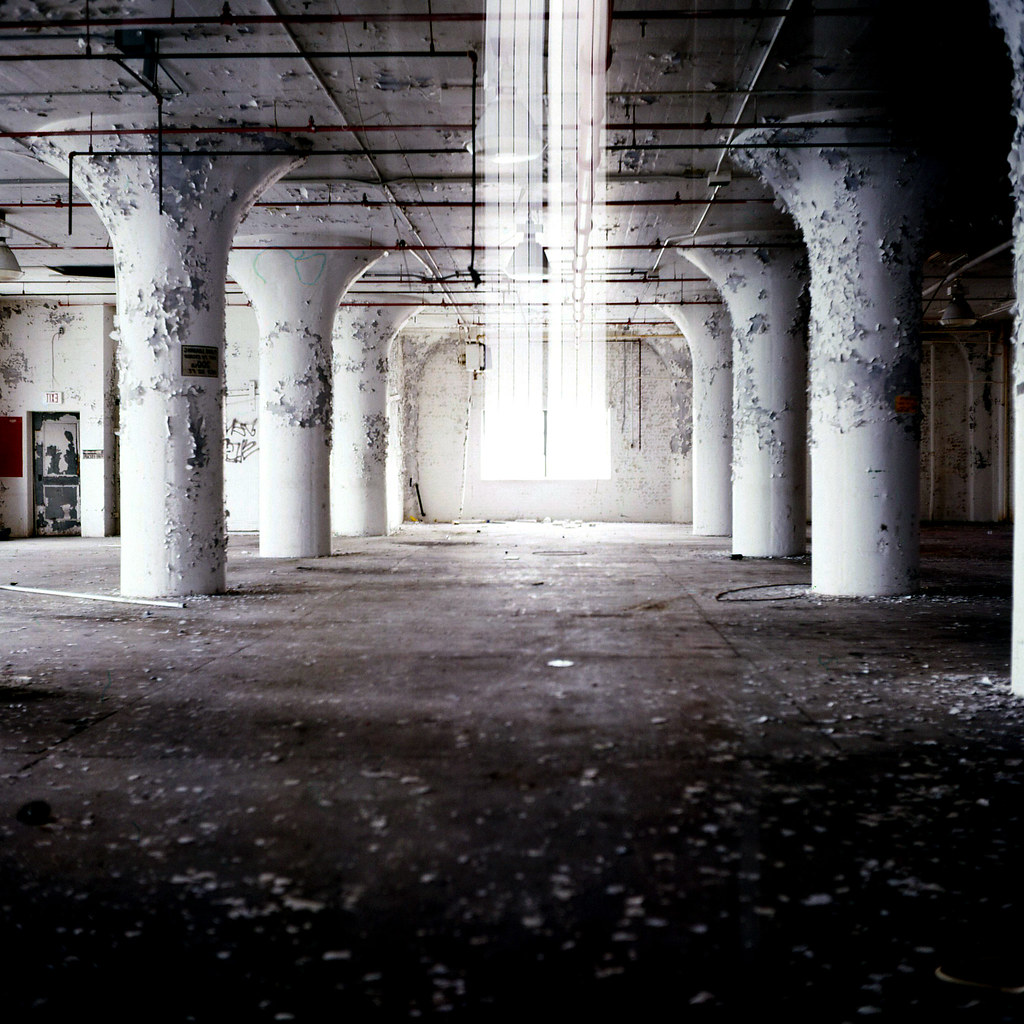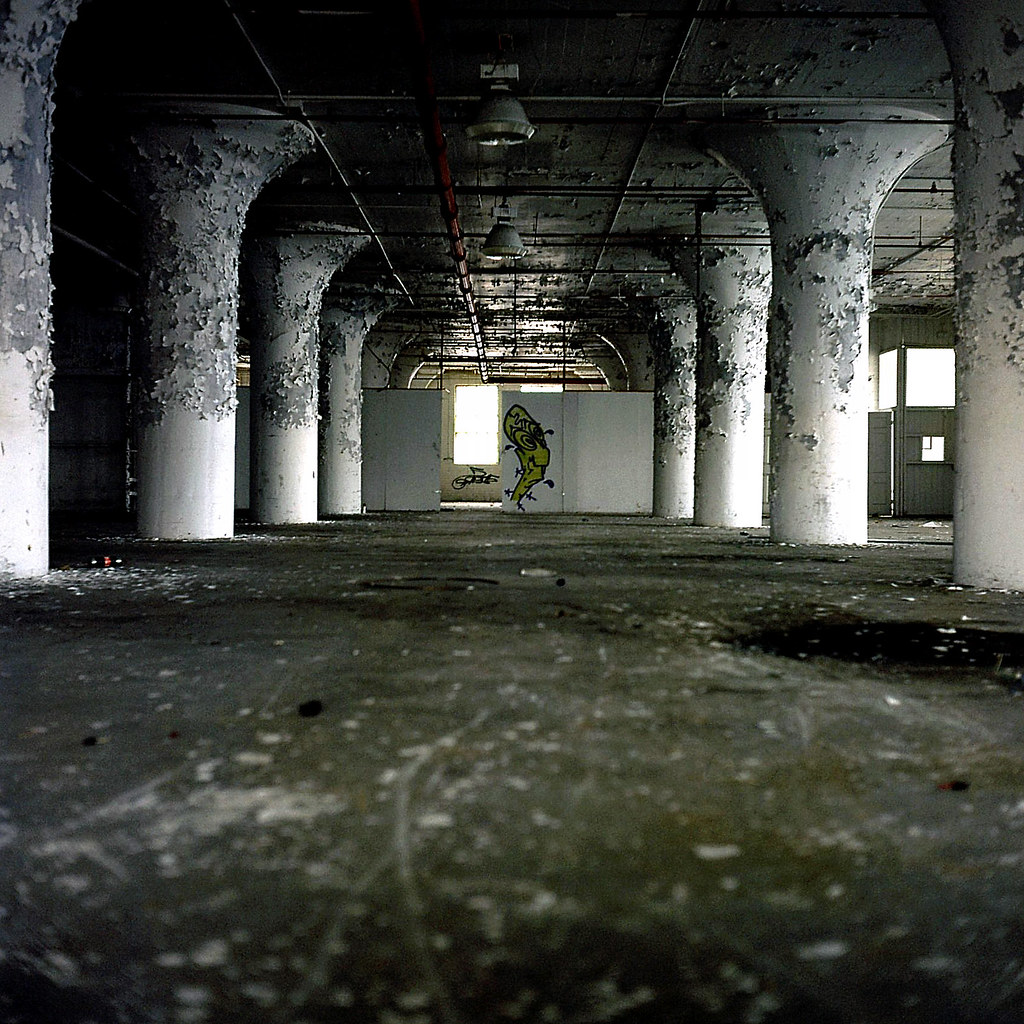I often mix up Tower Automotive with National Rubber, two former industrial locations in the Junction neighbourhood of Toronto. Today, the Junction is home to galleries, craft breweries, condo lofts, and other gentrified options, and it once was Toronto’s hotbed for industry. Founded along a significant trade path for indigenous peoples and growing into a railway junction starting in 1884, what we know as the Junction was a town in its own right until amalgamation into the City of Toronto in 1909. The Tower building became part of the skyline. While it stands out as a beautiful example of early 20th-century architecture, it is far rougher up close than viewed from a distance. Unlike many abandoned buildings I have written about, the Tower Building has a happier ending.

Nikon D300 – AF-S Nikkor 17-55mm 1:2.8G DX
At one time, aluminium was a costly and rare metal that commanded high prices due to the difficulty of producing what we see as ordinary metal today. The earliest attempts to make aluminium were in 1760. Success would only be achieved in 1824 by Danish chemist Hans Christian Ørsted who reacted anhydrous aluminium chloride with potassium amalgam, yielding a lump of metal similar to tin. It was not until the late 19th Century that large-scale industrial production started with the Hall–Héroult process in 1886, which was further improved by the Bayer process in 1889. In 1888, the Pittsburg Reduction Company (Alcoa since 1907) used the Hall–Héroult process to produce aluminium. In 1902, Alcoa opened a Canadian subsidiary, the Northern Aluminum Company, in Shawinigan, Quebec. The company quickly grew and began to open up operations across Canada, including in the former town of West Toronto in 1910. The operation soon grew, and the company hired noted architect John Woodman, who collaborated with Claude Turner to construct a modern ten-storey vertical factory using cast concrete. Construction of the tower started in 1919, and by 1920, the building was in operation and focused mainly on producing kitchen utensils and cutlery. From a distance, the building appeared well-refined, but once you got in close, you saw that it did not seem as finished; it was, after all, a factory. In 1925, the company rebranded to the Aluminum Company of Canada and three years later split from the American parent company. In 1937, a new rolling mill was added to the Toronto factory to meet the growing demand, allowing the company to command 75% of the aluminium market across the British Empire. During the war, the company saw its income increase by six times what it had brought in before the war. War production focused mainly on aluminium parts for the aircraft industry.

Nikon D70s – Tamron SP AF 11-18mm 1:4.5-5.6 DiII
Nikon D70s – Tamron SP AF 11-18mm 1:4.5-5.6 DiII
Nikon D70s – Tamron SP AF 11-18mm 1:4.5-5.6 DiII
Nikon D70s – Tamron SP AF 11-18mm 1:4.5-5.6 DiII
Nikon D70s – Tamron SP AF 11-18mm 1:4.5-5.6 DiII
Emerging from the war, the Aluminum Company of Canada rebranded to the simpler ALCAN in 1945. While the company did see a dip in the immediate post-war, it quickly retooled to produce aluminium siding and wiring to aid in the construction boom that was taking place outside of the city, along with supplying parts for the growing automotive sector. By 1975, Alcan was the sixth largest company in Canada. Still, the cracks were starting to show as the manufacturing industry took a hit in the later half of the century. It’s here that the history gets a bit muddy; the Tower in Toronto was renamed Algoods but retained a connection to Alcan until 1994, when they started to divest some of their Toronto locations, including a second plant in Scarborough. I am not sure what happened to the Tower at this point. Still, it was in 2000 that Tower Automotive took over operations and began strictly automotive part construction. The company lasted for six years before declaring bankruptcy and closing up shop. The contents of the building were sold off at an auction a year later. The Tower received a historic designation in 2005, and the landmark building had many mixed-use goals. Since the 1970s, the entire face of the Junction had started to change as artists began to take advantage of the old industrial locations that offered up cheap studio space. But at the end of the decade, the area started to see gentrification. 2015, the Museum of Contemporary Canadian Art announced that it had purchased the old Tower Automotive building. It started the demolition of the newer factory sections to transform the Tower into a mixed museum and studio space, with the grand opening in 2018.

Nikon D70s – Sigma DC 18-50mm 1:2.8 EX MACRO
Nikon D70s – Sigma DC 18-50mm 1:2.8 EX MACRO
Nikon D70s – Sigma DC 18-50mm 1:2.8 EX MACRO
Nikon D70s – Sigma DC 18-50mm 1:2.8 EX MACRO
Nikon D70s – Sigma DC 18-50mm 1:2.8 EX MACRO
I only have a vauge recollection of my travels to the Tower Automotive building. I know I went twice, but that is only because of the photo record. I also think that I get this spot confused with another nearby abandoned factory, National Rubber Inc. I’ll admit, the place was empty but cool simultaneously. However, the best offerings of the Tower plant were the significant roller mill expansion and the views of the downtown skyline from the top floors. I never reached the roof or saw the elevator control room. It is rumoured that the Tower building installed one of the first elevators in Canada. However, there is no evidence of this other than speculation. Both trips took place during the Toronto UER meetups, which, while mainly for socialising, always ended with some exploration being done. The one thing I do remember about Tower is showing the photos of the office furniture to people at work and mentioning that an abandoned building had better office furniture than a working office (the central IT office at Sheridan), which did result in a renovation and refresh of the office shortly after.

Nikon D70s – Sigma DC 18-50mm 1:2.8 EX MACRO
Nikon D70s – Sigma DC 18-50mm 1:2.8 EX MACRO
Nikon D70s – Sigma DC 18-50mm 1:2.8 EX MACRO
Nikon D70s – Sigma DC 18-50mm 1:2.8 EX MACRO
Nikon D70s – AF Nikkor 50mm 1:1.8D
I’m unsure what to think about my photos from Tower Automotive; for the first bit, I could only find a handful of images I shot with the D300. Those were a mix of shots with 50mm and the Lens Baby Composer, and they were rather dull. I got those while I had the Yashica-12 on the tripod and using film, but more later. The earlier photos I got with my D70s were the best. What surprised me is that I mixed it up with the lens, using the wide angle 11-18 and then switching to the standard 18-50 for the shots in the tower. I did this right to show off the size of the expansion area and then get that more minor sense of scale. Another explorer in the group may want to borrow the ultrawide. The one thing I did right is using post-processing to convert a series of images to black & white; I guess even before I shot black & white more readily, I was already looking at abandoned buildings with the monochromatic photos in mind. The one set of images that also stands out is my work with the Yashica-12. This was early on in my exploration with TLRs, the Yashica being the second camera of that type, but honestly, I love these. The use of expired slide film and the light streaks where I advanced the film before the shutter closed was a happy accident. The Yashica did not go on a lot of adventures. It was quickly replaced by the Rolleiflex, so the fact that I had these images is a rarity.

Yashica-12 – Yashica Yashinon 80mm f:3.5 – Fujifilm Velvia @ ASA-50 – Processing By: Silvano’s
Yashica-12 – Yashica Yashinon 80mm f:3.5 – Fujifilm Velvia @ ASA-50 – Processing By: Silvano’s
Yashica-12 – Yashica Yashinon 80mm f:3.5 – Fujifilm Velvia @ ASA-50 – Processing By: Silvano’s
Yashica-12 – Yashica Yashinon 80mm f:3.5 – Fujifilm Velvia @ ASA-50 – Processing By: Silvano’s
Yashica-12 – Yashica Yashinon 80mm f:3.5 – Fujifilm Velvia @ ASA-50 – Processing By: Silvano’s
One of the best parts about the Tower building is that you can go and visit it today, and it’s perfectly legal! I’m always happy when a location, no matter how small, is reused rather than demolished. The best part is that many of the interior elements have been preserved despite being restored and reused from the photos I’ve seen of the Museum of Contemporary Canadian Art interior. Those fluted columns are intact; in some cases, you can even see the graffiti left behind while the place sits empty. Of course, only the tower has been preserved as it was the only part to receive a heritage designation. While I have yet to visit, it is only a list of places in Toronto to visit. You can plan your own visit by visiting moca.ca! You can see all my images from Tower over on Flickr.
Glossary of Terms
Aluminum: A chemical element; it has symbol Al and atomic number 13. Aluminium has a density lower than that of other common metals, about one-third that of steel. It has a great affinity towards oxygen, forming a protective layer of oxide on the surface when exposed to air. Aluminium visually resembles silver, both in its color and in its great ability to reflect light. It is soft, nonmagnetic, and ductile.
Hall–Héroult Process: The Hall–Héroult process is the major industrial process for smelting aluminium. It involves dissolving aluminium oxide (alumina) (obtained most often from bauxite, aluminium’s chief ore, through the Bayer process) in molten cryolite and electrolyzing the molten salt bath, typically in a purpose-built cell. The Hall–Héroult process applied at industrial scale happens at 940–980°C and produces 99.5–99.8% pure aluminium. Recycling aluminum requires no electrolysis, thus it is not treated in this way.
Bayer Process: The Bayer process is the principal industrial means of refining bauxite to produce alumina (aluminium oxide) and was developed by Carl Josef Bayer. Bauxite, the most important ore of aluminium, contains only 30–60% aluminium oxide (Al2O3), the rest being a mixture of silica, various iron oxides, and titanium dioxide. The aluminium oxide must be further purified before it can be refined into aluminium.